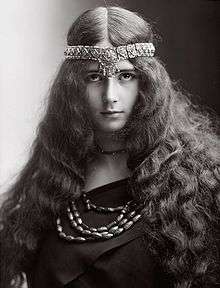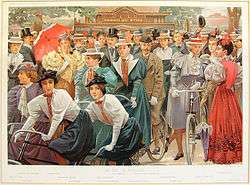Cléo de Mérode
Cléopâtre-Diane de Mérode (27 September 1875 – 17 October 1966) was a French dancer of the Belle Époque.[1]
Cléo de Mérode | |
|---|---|
 Cléo de Mérode by Nadar, 1895 | |
| Born | Cléopâtre-Diane de Mérode 27 September 1875 |
| Died | 17 October 1966 (aged 91) Paris, France |
| Resting place | Père Lachaise Cemetery |
| Occupation | Dancer |
| Years active | 1886–late 1920s |
| Signature | |
Biography
Cléo de Mérode was born in Paris, France on 27 September 1875.[2] She was the illegitimate[3] daughter of Viennese Baroness Vincentia de Mérode, of Austrian and Belgian descent,[4][5] who was estranged from Cléo's father. She was raised Catholic. At the age of eight, Cléo was sent to study dance and made her professional debut at age eleven.
Mérode became renowned for her glamour even more than for her dancing skills, and her image began appearing on such things as postcards and playing cards. A particular new hairstyle she chose to wear became the talk of Parisian women and was quickly adopted as a popular style for all. Her fame was such that Alexandre Falguière sculpted The Dancer in her image, which today can be seen in the Musée d'Orsay. In 1895, Henri de Toulouse-Lautrec did her portrait, as would Charles Puyo, Alfredo Muller, and Giovanni Boldini. Her picture was taken by some of the most illustrious photographers of the day, including Félix Nadar.

In 1896, King Leopold II attended the ballet and saw Mérode dance. The 61-year-old Belgian king became enamoured with the 21-year-old ballet star, and gossip started that she was his latest mistress. Because the King had had two children with a woman reputed to be a prostitute, Mérode's reputation suffered, and she had to live with it for the rest of her life. Nevertheless, she became an international star, performing across Europe and in the United States. At the peak of her popularity, she chose to dance at the Folies Bergère, taking the risk to do something other elites of the ballet had never done before. Her performance gained her a whole new following.
Very popular in Austria as well as in Germany, her character appeared in the German film Women of Passion (1926), played by Fern Andra. In Vienna, her beauty caught the attention of painter Gustav Klimt, whose primary focus was on female sexuality. Their story was the basis of the film Klimt, in which the character "Lea de Castro" is based on Cléo de Mérode.
Mérode continued to dance until her early fifties, when she retired to the seaside resort of Biarritz in the Pyrénées-Atlantiques département of France. She then taught ballet before retiring in 1965 at 90 years old.[6]
In 1950, Mérode sued Simone de Beauvoir for libel for calling her a courtesan in her book The Second Sex. Mérode won the lawsuit, and the passage was taken out of the book.[7]
In 1955, she published her autobiography, Le Ballet de ma vie (The Dance of My Life).[8]
Mérode never married or had children, and she claimed in her autobiography that she had only been involved with two men in her life. She was engaged to a French aristocrat for nearly ten years before he died of Typhoid fever in 1904, and she was the companion of the Spanish sculptor and diplomat Luis de Périnat (1872–1923) from 1906 to 1919.[9]
She was a vegetarian.[10]
Cléo de Mérode died on 17 October 1966 and was interred in the Père Lachaise Cemetery in Paris in Division 90. A statue of her by Luis de Périnat, mourning her mother, who is interred in the same plot, decorates the gravestone.
Gallery
 circa 1903
circa 1903 Photograph by Léopold Reutlinger, 1901 (ballet Lorenza)
Photograph by Léopold Reutlinger, 1901 (ballet Lorenza) Cléo de Mérode in three different poses (from Le Théâtre, décembre 1898)
Cléo de Mérode in three different poses (from Le Théâtre, décembre 1898) Photograph by Charles Ogerau, 1902
Photograph by Charles Ogerau, 1902 Photograph by Charles Ogerau, 1895[11]
Photograph by Charles Ogerau, 1895[11] Photograph by Léopold Reutlinger, 1901 (ballet Lorenza)
Photograph by Léopold Reutlinger, 1901 (ballet Lorenza) Photograph, 1897
Photograph, 1897 Photograph, 1900
Photograph, 1900
(La Cambodgienne)
See also
References
- Jaffe, Aaron, and Goldman, Jonathan (2010). Modernist Star Maps: Celebrity, Modernity, Culture. Ashgate Publishing, Ltd. p. 137. ISBN 0754666107.
- Paris Archives. 1875, Naissances, 05 V4E 3017. #2179. http://archives.paris.fr
- Edward Ross Dickinson (2017). Dancing in the Blood: Modern Dance and European Culture on the Eve of the First World War. Cambridge University Press. p. 112.
- Catherine Authier (2015). Femmes d'exception, femmes d'influence : Une histoire des courtisanes au XIXe siècle. Armand Colin. p. 221.
- Paul Bauer (2006). 2 siècles d'histoire au Père Lachaise. Mémoire & Documents. p. 551.
- Spackman, Ellis L. (17 November 1966). "Romantic Life Sparked Longevity". The San Bernardino Sun. 73. p. D-22.
- "One Franc Damages". The West Australian. 66 (20055). Reuters. 27 October 1950. p. 8.
- Garval, Michael D. (2012). Cléo de Mérode and the Rise of Modern Celebrity Culture. Ashgate Publishing, Ltd. p. 38. ISBN 1409406032.
- Michael D. Garval (2012). Cléo de Mérode and the Rise of Modern Celebrity Culture. Ashgate Publishing.
- "Notable Vegetarians". The Literary Digest. Vol. 42 no. 21. 24 May 1913. pp. 1196–1199.
- This was chosen by Mérode to illustrate the cover of her memoirs, in 1955.
Bibliography
- Cléo de Mérode, Le Ballet de ma vie, Paris, Pierre Horay, 1955, 277 p., ill.
- Christian Corvisier, Cléo de Mérode et la photographie, la première icône moderne, Paris, éditions du Patrimoine, 2007, 127 p., 150 ill.
- Cleo de Merode and the rise of modern celebrity culture, Choice Reviews Online Año:2013 vol.:50 iss:10 pág.:50 -50-5484
- The Last Symbolist Poet.(Art), Time, Hughes, Robert Año:1976 vol.:107 iss:10 pág.:74
- Acts of Containment: Marianne Moore, Joseph Cornell, and the Poetics of Enclosure, Journal of Modern Literature; Philadelphia, Falcetta, Jennie-Rebecca Año:2006 vol.:29 iss:4 pág.:124 -144